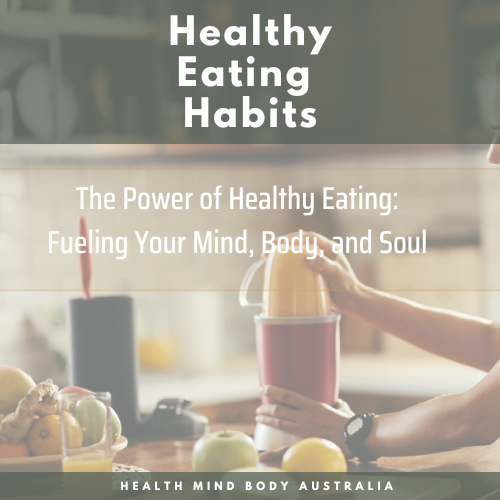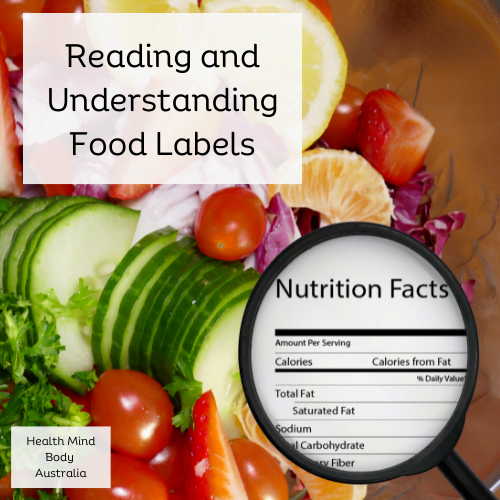The Power of Healthy Eating: Fueling Your Mind, Body, and Soul
Are you tired of feeling sluggish, unmotivated, and just not your best self?
Well, I know exactly how you feel, because I’ve been there too.
My name is Amy, and I’m a passionate advocate for healthy living.
Today, I want to share with you the importance of healthy eating and how it can transform your life.
As the founder of Health Mind Body Australia, I believe that nourishing your body with the right nutrients not only enhances your physical well-being but also profoundly impacts your mental and emotional state.
So let’s dive right in!
Key Components of Healthy Eating
To achieve a healthy eating lifestyle, it’s important to focus on key components, some of those consisting in:
Balanced Macronutrients
Ensure your meals include a balance of carbohydrates, proteins, and healthy fats.
Opt for whole grains, lean meats, fish, legumes, nuts, and seeds.
Abundance of Fruits and Vegetables
Aim to include a variety of colourful fruits and vegetables in your diet.
They are packed with vitamins, minerals, and antioxidants that support your overall health.
Mindful Portion Control
Pay attention to portion sizes and listen to your body’s hunger and fullness cues.
Eating mindfully can help you maintain a healthy weight and avoid overeating.
Adequate Hydration
Hydration is crucial for your overall health.
Aim to drink an adequate amount of water throughout the day to maintain proper bodily functions, support digestion, and promote optimal function.
Remember to listen to your body’s thirst cues and choose water as your primary choice of hydration.
Quality Protein Sources
In addition to lean meats, fish, and legumes, consider incorporating alternative protein sources into your diet, such as tofu, quinoa, and Greek yogurt.
Protein is essential for tissue repair, muscle development, and satiety.

Healthy Fats
Include sources of healthy fats in your meals, such as avocados, nuts, seeds, and olive oil.
These fats provide essential fatty acids, promote brain health, support hormone production, and aid in the absorption of fat-soluble vitamins.
Minimise Added Sugars
Limit your consumption of added sugars, as they contribute to weight gain, inflammation, and an increased risk of chronic diseases.
Be mindful of hidden sugars in processed foods and opt for natural sweeteners like fruits or small amounts of honey or maple syrup when needed.
Whole Foods
Choose whole, unprocessed foods whenever possible.
Processed foods tend to be higher in unhealthy fats, sodium, and additives, while whole foods retain their natural nutrients and provide a more complete nutritional profile.
Variety and Moderation
Embrace a diverse range of foods to ensure you receive a wide variety of nutrients.
Incorporate different fruits, vegetables, whole grains, and proteins into your meals.
Practice moderation and balance, enjoying all foods in reasonable portions without depriving yourself or overindulging.
Regular Meal Patterns
Establish regular eating patterns and aim for consistent meal times.
Skipping meals or erratic eating patterns can lead to overeating or making unhealthy food choices due to extreme hunger.
Remember, the key to sustainable healthy eating is finding a balance that works for you.
It’s not about strict rules or deprivation but rather about nourishing your body with wholesome, nutrient-rich foods while still enjoying the foods you love in moderation.
The Benefits of Healthy Eating
The benefits of healthy eating extend far beyond just physical health.
Scientific research has shown that a well-balanced diet rich in fruits, vegetables, lean proteins, and whole grains can have a positive impact on our overall well-being.
As stated on the WHO website, healthy eating helps to protect against malnutrition, as well as diseases such as cancer, heart disease, and diabetes.
Here are some key benefits to healthy eating:
Physical Well-Being
A healthy diet can help you maintain a healthy weight, reduce the risk of chronic diseases such as heart disease, diabetes, and certain cancers, and improve your energy levels and stamina.
Mental Clarity
Nutrient-rich foods supply the brain with the essential vitamins, minerals, and antioxidants it needs to function optimally.
This can enhance your focus, concentration, and memory, while also reducing the risk of age-related cognitive decline.
Emotional Balance
Healthy eating supports the production of neurotransmitters, such as serotonin, which play a crucial role in regulating mood and emotions.
A well-nourished body can help alleviate symptoms of anxiety and depression.
Stronger Immune System
A nutritious diet supports a robust immune system, helping your body fend off illnesses and infections.
A well-nourished immune system can reduce the frequency and severity of common colds and flu.
Improved Digestive Health
A diet rich in fibre from fruits, vegetables, and whole grains promotes a healthy digestive system.
It can prevent constipation, support regular bowel movements, and reduce the risk of digestive disorders.
Enhanced Skin Health
Your skin reflects your inner health, and a nutritious diet can contribute to a radiant complexion. Consuming foods high in antioxidants, vitamins, and healthy fats can help reduce skin inflammation, promote elasticity, and prevent premature aging.
Better Sleep Quality
Certain foods contain sleep-promoting compounds, such as tryptophan and magnesium, that can help regulate your sleep patterns.
By incorporating foods like almonds, bananas, and whole grains into your diet, you can improve the quality and duration of your sleep.
Increased Energy and Vitality
A balanced diet provides the necessary nutrients to fuel your body and sustain energy levels throughout the day.
By avoiding sugary snacks and opting for nutrient-dense foods, you can experience sustained energy, improved productivity, and reduced midday crashes.
Stronger Bones and Teeth
Adequate intake of calcium, vitamin D, and other essential minerals is crucial for maintaining healthy bones and teeth.
Incorporating dairy products, leafy greens, and fortified foods into your diet can help prevent osteoporosis and tooth decay.
Longevity and Disease Prevention
Studies consistently show that a healthy diet is associated with a lower risk of chronic diseases such as heart disease, stroke, type 2 diabetes, and certain types of cancer.
By nourishing your body with a variety of nutrient-rich foods, you can potentially increase your lifespan and enjoy a higher quality of life.
Remember, these benefits are not isolated but interconnected.
When you prioritise healthy eating, you are nurturing your entire body, promoting overall well-being, and setting the stage for a vibrant and fulfilling life.
Understanding Food Labels and Nutrition
Reading food labels is essential for making informed choices.
Look for labels that list recognisable ingredients and avoid products high in added sugars, unhealthy fats, and artificial additives.
Pay attention to serving sizes and the nutrient content per serving.
Understanding food labels is a critical skill in making informed decisions about the nutritional content of the foods you consume.
Here are some key points to consider:
Ingredients List
The ingredients list provides valuable information about the composition of the food.
Look for labels that list recognisable and whole food ingredients at the beginning of the list.
Ingredients are listed in descending order by weight, so the first few ingredients are the most prominent. Avoid products that contain artificial additives, preservatives, or ingredients that you are unfamiliar with.
Serving Size
Pay attention to the serving size indicated on the label.
This information is important because all the nutrient values on the label are based on this specified serving size.
Be mindful of portion sizes and adjust your consumption accordingly.
Nutrient Content
The nutrient content section of the label provides information about the amounts of specific nutrients in the product.
Total Calories
This indicates the total energy content per serving.
Consider whether the calorie count fits into your overall dietary goals.
Macronutrients
Look for information on the content of carbohydrates, proteins, and fats.
Be aware of the types of fats, focusing on unsaturated fats such as monounsaturated and polyunsaturated fats and limiting saturated and trans fats.
Fibre
Aim for foods that are high in dietary fibre.
Fibre aids digestion, promotes satiety and can help manage blood sugar levels.
Added Sugars
Identify the amount of added sugars in the product.
Added sugars contribute to empty calories and can lead to health issues when consumed excessively. Limit your intake of products with high amounts of added sugars.
Sodium
Keep an eye on the sodium content, especially if you need to manage your blood pressure.
Opt for lower-sodium options when possible.
Percent Daily Value (%DV)
The %DV listed on the label indicates how much of a specific nutrient one serving of the food contributes to your recommended daily intake.
Use the %DV as a general guide to evaluate the nutritional value of the product.
Aim for foods that provide higher percentages of beneficial nutrients like vitamins, minerals, and fibre, while keeping the %DV of saturated fats, sodium, and added sugars lower.
Remember, food labels are a tool to help you make informed choices, but they should be considered in the context of your overall dietary goals and needs.
Focus on whole, unprocessed foods whenever possible, as they often have fewer labels and are naturally nutritious.
Incorporating Healthy Eating into Your Lifestyle
Making healthy eating a seamless part of your lifestyle can be achieved with these tips:
Meal Prep
Planning and preparing your meals in advance is a key strategy for maintaining a healthy eating routine. Set aside dedicated time each week to plan your meals, create a grocery list, and prepare your ingredients.
Consider batch cooking, where you cook larger portions and divide them into individual servings for the week.
This saves time and ensures you have healthy meals readily available, even on busy days.
Smart Grocery Shopping
Making healthy choices at the grocery store sets the foundation for your eating habits.
Before heading to the store, make a shopping list based on your planned meals and stick to it.
Shop the perimeter of the store, where fresh produce, lean meats, and dairy products are typically located.
This way, you’ll be prioritising whole foods and minimising exposure to processed and sugary items found in the inner aisles.
Remember to read food labels and choose products with minimal added sugars, unhealthy fats, and artificial additives.
Cooking Tips
Experimenting with different cooking methods can enhance the flavour and nutritional value of your meals.
Try grilling, baking, steaming, sautéing, or stir-frying your ingredients to retain their nutrients and natural flavours.
Avoid deep-frying or excessively using oils and opt for healthier alternatives like herbs, spices, and citrus juices to add flavour.
Explore new recipes and cuisines to keep your meals exciting.
Incorporating a variety of colourful fruits, vegetables, whole grains, and lean proteins into your meals will ensure a well-rounded and nutritious diet.
Mindful Eating
Slow down and pay attention to your eating experience.
Chew your food thoroughly, savour the flavours, and listen to your body’s hunger and fullness cues. Eating mindfully allows you to enjoy your meals more fully, prevents overeating, and promotes better digestion.
Social Support
Engage with like-minded individuals who share your goals of healthy eating.
Join online communities or seek support from friends and family members who can provide encouragement and share healthy recipes and tips.
Having a support system can make the journey to healthy eating more enjoyable and sustainable.
Make it Fun
Healthy eating doesn’t have to be boring or restrictive.
Experiment with new ingredients, spices, and flavours.
Try new fruits and vegetables, explore international cuisines, and get creative in the kitchen.
Healthy eating can be an exciting culinary adventure that expands your palate and keeps you motivated.
Remember, healthy eating is a lifestyle change, and it’s essential to find strategies that work for you.
Making Healthy Eating a Habit
To make healthy eating a habit, try implementing and following these suggestions:
Set Realistic Goals
Start with small, achievable goals such as adding an extra serving of vegetables to your meals or swapping sugary drinks for water.
Gradually build on these goals over time.
Track Your Progress
Keep a food diary or use mobile apps to track your food intake and monitor your progress.
This will help you stay accountable and identify areas for improvement.
Be Consistent
Consistency is key when forming a habit.
Aim to make healthy eating a regular part of your daily routine.
Plan your meals, set specific times for eating, and prioritise nutritious choices consistently.
Mindset Shift
Adopt a positive and sustainable mindset towards healthy eating.
Rather than viewing it as a restrictive diet or short-term fix, embrace it as a long-term lifestyle choice that nourishes your body and promotes overall well-being.
Focus on the benefits you will gain from healthy eating, such as increased energy, improved mood, and better health.
Gradual Changes
Instead of attempting drastic dietary changes overnight, start by making small, manageable adjustments. This approach allows you to gradually adapt to new tastes and habits.
For example, try incorporating one new vegetable into your meals each week or replacing unhealthy snacks with healthier options.
Plan Ahead
Planning is crucial for maintaining healthy eating habits.
Plan your meals in advance, create a grocery list, and ensure you have nutritious ingredients readily available.
This will help you avoid impulsive and unhealthy food choices when hunger strikes.
Make Healthy Eating Convenient
Create an environment that supports healthy eating.
Keep your kitchen stocked with wholesome ingredients, organise your pantry and refrigerator to prioritise healthier options, and have healthy snacks on hand for when you’re on the go.
Making healthy choices easily accessible and convenient will increase the likelihood of sticking to them.
Find Healthy Alternatives
Identify healthier alternatives to your favorite indulgent foods.
For example, swap refined grains with whole grains, replace sugary beverages with herbal tea or infused water, and choose healthier cooking methods like baking or grilling instead of deep-frying.
Experiment with new recipes that offer a healthier twist on traditional dishes.
Seek Support
Enlist the support of family, friends, or a community with similar health goals.
Share your journey with them, exchange ideas and recipes, and hold each other accountable.
Having a support system can provide motivation, encouragement, and a sense of camaraderie.
Remember, healthy eating is a lifelong journey, and it’s normal to have occasional slip-ups.
Be kind to yourself and focus on progress rather than perfection.
Each day is an opportunity to make positive choices that contribute to your overall well-being.
Addressing Common Obstacles
While adopting a healthy eating lifestyle, you may encounter obstacles such as time constraints, cravings, and social pressures. Here are practical solutions:
Time Constraints
Time constraints can make it challenging to prioritise healthy eating.
However, with some planning and preparation, it is possible to overcome this obstacle:
Meal Planning
Set aside time each week to plan your meals.
Consider batch cooking and preparing ingredients in advance to save time during busy weekdays.
Kitchen Gadgets
Utilise time-saving kitchen gadgets like a slow cooker, or food processor to simplify meal preparation. These tools can help you cook meals more efficiently.
Quick and Easy Recipes
Look for quick and simple recipes that require minimal cooking time.
There are numerous resources available, such as cookbooks, websites, and apps, that provide healthy recipes designed for busy individuals.
Cravings
Cravings for unhealthy foods can be a common challenge.
Here are some strategies to address cravings:
Find Healthy Alternatives
Look for healthier versions of your favorite indulgent foods.
For example, if you crave something sweet, opt for a piece of fruit or a small portion of dark chocolate instead of reaching for processed sweets.
Balanced Meals
Ensure that your meals are well-balanced and contain a combination of protein, healthy fats, and fibre-rich carbohydrates.
This can help stabilise your blood sugar levels and reduce cravings.
Mindful Eating
When you experience a craving, pause and check in with your hunger levels.
Is the craving due to actual hunger, or is it triggered by emotional or environmental factors?
If it’s not true physical hunger, find alternative ways to address the underlying need, such as engaging in a hobby, going for a walk, or practicing relaxation techniques.
Social Pressures
Social situations can present challenges to maintaining healthy eating habits.
Here’s how you can navigate social pressures:
Communicate Your Goals
Share your dietary preferences and health goals with your friends, family, and colleagues.
Let them know that you are committed to making healthier choices and kindly ask for their support.
Be Prepared
When attending social gatherings or eating out, plan ahead by looking at the menu in advance and choosing healthier options.
If necessary, eat a small, nutritious snack beforehand to curb your hunger and make it easier to resist unhealthy temptations.
Find Support
Seek out like-minded individuals who are also committed to healthy eating.
Join online communities, participate in local health and wellness groups, or find an accountability partner. Having support and encouragement from others can make a significant difference in staying motivated and navigating social situations.
Remember, addressing obstacles is an ongoing process, and it’s important to be flexible and adaptable. Each individual’s journey is unique, and finding strategies that work for you personally will help you overcome common challenges and maintain a healthy eating lifestyle.
My Tips for Creating Healthy Eating Habits
I have personally found the below helpful during my journey:
Sustainability
Choosing a healthy lifestyle that is sustainable and allows for flexibility is crucial for long-term success.
It’s not just about following strict rules or rigid routines; it’s about finding a balance that works for you and can be maintained over time.
By incorporating healthy habits into your daily life that you enjoy and can sustain, can ensure you set yourself up for success in the long run.
Sustainability means finding ways to nourish your body, mind, and soul without feeling deprived or restricted.
It’s about making informed choices, practicing moderation, and embracing flexibility to accommodate different circumstances and situations.
This approach promotes a positive and realistic mindset towards health, fostering a lifelong commitment to your well-being.
Remember, it’s not about perfection, but progress and consistency on your journey towards a healthier and happier you.
Hydration
Hydration plays a crucial role in maintaining a healthy eating routine.
Proper hydration is essential for overall well-being and supports optimal digestion, nutrient absorption, and metabolism, and supports your body’s vital functions.
Mindful Eating
Mindful eating is about savouring each bite, being present in the moment, and paying attention to your body’s hunger and fullness cues.
By practicing mindful eating, you can develop a deeper connection with your food, enhance your digestion, and make more conscious choices that support your overall well-being.
Variety and Moderation
When it comes to healthy eating, two key principles reign supreme – variety and moderation. Incorporating a diverse range of foods ensures that you receive a wide spectrum of essential nutrients, while moderation helps you maintain a balanced approach to your diet.
Long-Term Approach
Taking a long-term approach to your health and well-being is essential for sustainable success.
It involves shifting your focus from short-term results to lifelong habits and behaviours.
Instead of pursuing quick fixes or fad diets, you prioritise building a foundation of healthy practices that can be sustained over time.
A long-term approach recognises that true transformation takes time and patience.
It encourages gradual progress, allowing you to make small, manageable changes that become integrated into your daily life.
This approach promotes consistency rather than perfection, emphasising the importance of sustainable habits rather than short-lived extremes.
Seek Professional Guidance
Seeking professional guidance is a valuable step in your journey towards a healthy lifestyle.
While self-education and personal experimentation can be helpful, consulting with a qualified healthcare professional or registered dietitian can provide you with expert knowledge, personalised advice, and tailored recommendations.
Final Thoughts – The Power of Healthy Eating
The importance of healthy eating cannot be overstated.
It is a powerful tool that can positively impact your physical health, mental well-being, and overall quality of life.
By prioritising nutrient-rich foods, practicing mindful eating, and making conscious choices, you can embark on a journey towards optimal health and vitality.
From understanding food labels to incorporating healthy eating into your lifestyle, we have explored key components that contribute to a well-rounded approach to nutrition.
By setting realistic goals, tracking your progress, and addressing common obstacles, you can overcome challenges and make healthy eating a sustainable habit.
Let us remember the benefits of healthy eating:
- increased energy,
- reduced risk of chronic diseases,
- improved mental clarity,
- and emotional balance.
These benefits are within your reach, supported by scientific research, and backed by the experiences of countless individuals who have transformed their lives through healthy eating.
I invite you to visit Health Mind Body Australia to further explore the wealth of resources and information available to support your journey towards a healthier lifestyle.
Together, let’s make small changes that have a big impact.
Start by incorporating one healthy habit into your daily routine and build upon it gradually.
The power to transform your well-being lies in your hands, one bite at a time.
Embrace the potential of healthy eating and unlock a life of vitality, nourishment, and fulfillment.
By incorporating these tips into your routine, you’ll gradually develop healthy habits that will become second nature over time.
You can also find me on my socials, Come say Hi!
Amy xx
This page contains affiliate links. If you choose to make a purchase after clicking a link, I may receive a commission at no additional cost to you.






